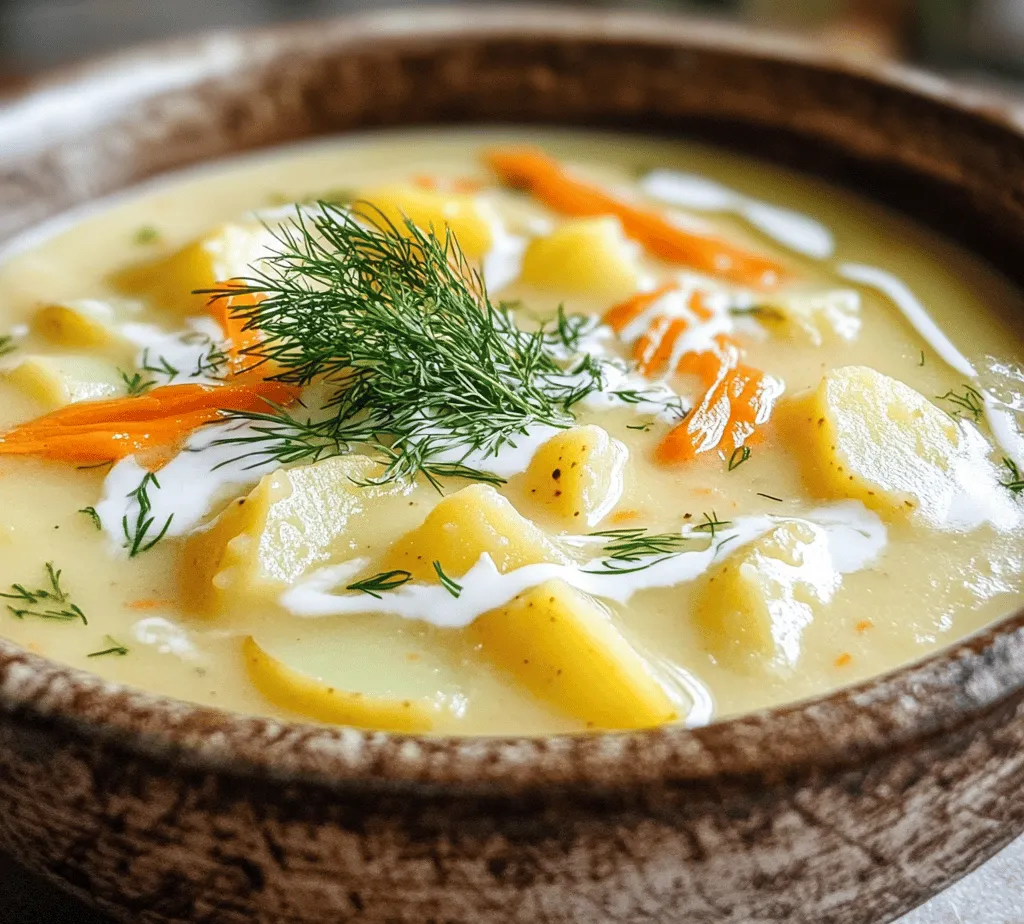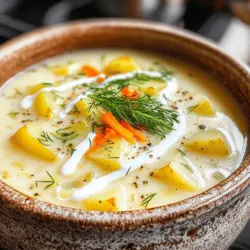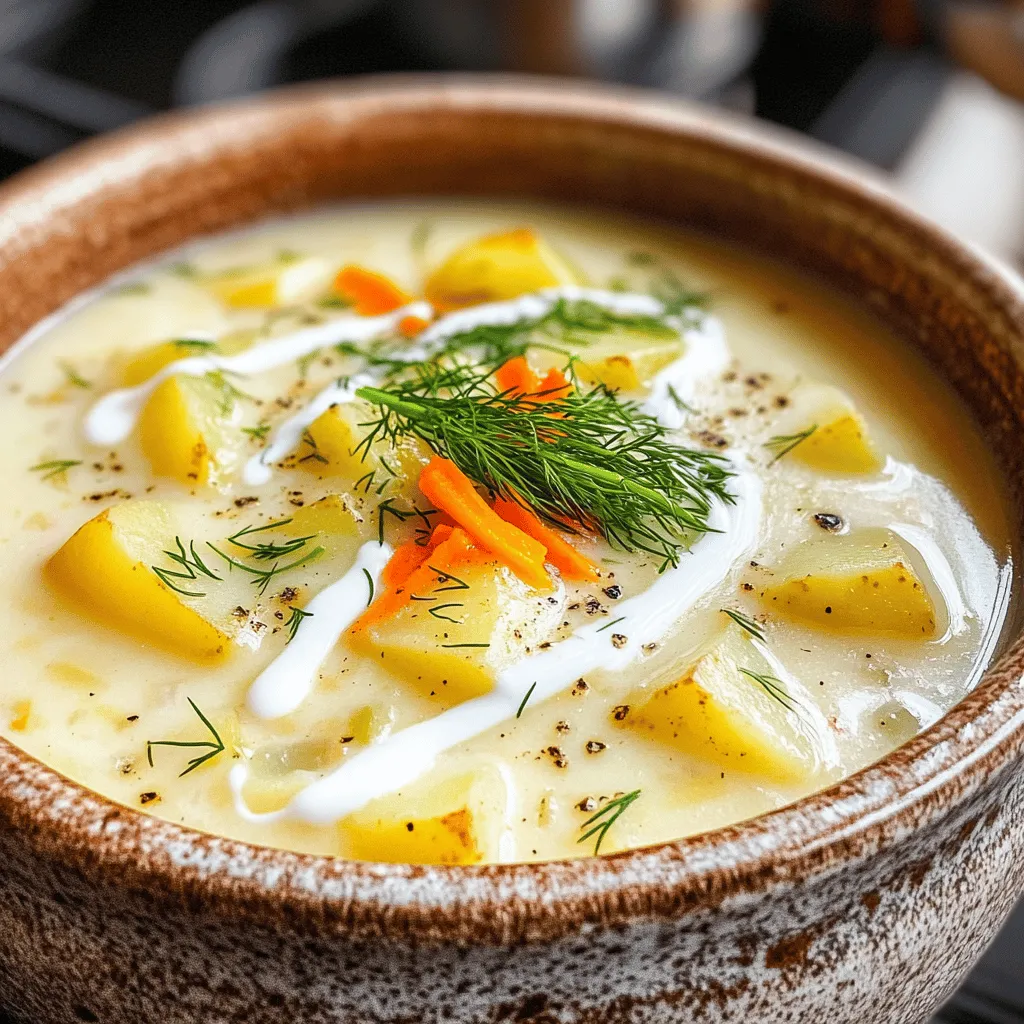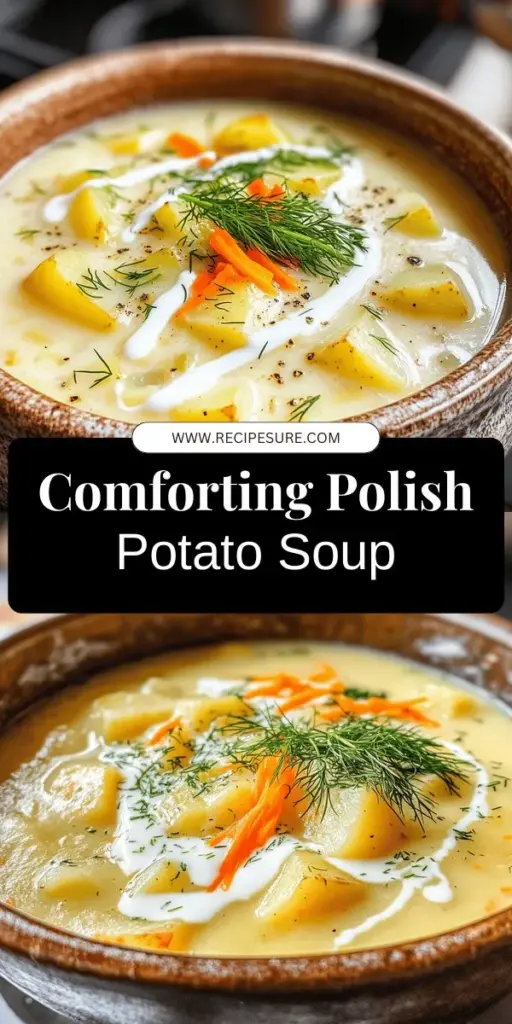When the chill of winter sets in, nothing warms the heart and soul quite like a bowl of soup. Among the numerous varieties that grace our tables, Warm & Hearty Polish Potato Soup stands out as a quintessential comfort food that encapsulates the very essence of Polish culinary tradition. This rich and creamy soup not only provides a satisfying meal but also evokes a sense of nostalgia and warmth that can transport you to the quaint kitchens of Poland. In this article, we will explore the origins of this delightful recipe, break down its essential ingredients, and provide a comprehensive guide to preparing this comforting dish from scratch.
The Origins of Polish Potato Soup
Polish Potato Soup, or “Zupa Ziemniaczana,” has deep roots in Eastern European cuisine, where potatoes have been a staple food source for centuries. The humble potato, originally brought to Europe from South America in the late 16th century, quickly became integral to the diets of many Eastern European countries, including Poland. Known for their versatility and heartiness, potatoes can be transformed into various dishes, making them a beloved ingredient in Polish households.
Historically, Polish cuisine has been influenced by a blend of cultures due to its geographical location, which has led to a rich culinary tapestry. Potato soup is a dish that reflects this diversity, with regional variations found throughout Poland. For instance, some regions may incorporate smoked meats or different herbs, while others keep it simple with just vegetables and broth. Regardless of the variation, the core of the dish remains the same: a celebration of potatoes and their ability to provide comfort and sustenance.
In Poland, soup is more than just a dish; it is a cultural ritual. Traditionally served as a first course, soups are a staple in Polish homes, especially during cold months. They are often made in large batches, allowing families to enjoy the warmth of a homemade meal together. The preparation of Polish Potato Soup is often a communal activity, where family members gather in the kitchen, sharing stories and laughter while peeling potatoes and chopping vegetables. This sense of togetherness is a fundamental aspect of Polish culture, and it is beautifully encapsulated in this beloved soup.
Ingredients Breakdown
To create a Warm & Hearty Polish Potato Soup that truly resonates with the traditional flavors, it’s essential to understand the role of each ingredient in the recipe. Here’s a detailed analysis of the components that contribute to the soup’s rich flavor and comforting texture:
Potatoes
At the heart of this soup are the potatoes. Not only do they provide the primary texture and body of the dish, but they are also packed with nutrients. Potatoes are an excellent source of vitamins C and B6, potassium, and dietary fiber. When selecting potatoes for your soup, opt for starchy varieties like Russets or Yukon Golds, as they break down nicely during cooking and contribute to a creamy consistency.
Onions
Onions serve as the aromatic base for the soup, enhancing its overall flavor profile. They add a subtle sweetness and depth that is crucial for balancing the earthiness of the potatoes. Onions are also rich in antioxidants and have anti-inflammatory properties, making them a healthy addition to any dish.
Carrots
Carrots are included in the recipe not only for their natural sweetness but also for their vibrant color, which adds visual appeal to the soup. Rich in beta-carotene, carrots are a great source of vitamins A, K, and C. They bring a hint of sweetness that complements the savory elements of the soup.
Celery
Celery contributes aromatic qualities and a slight crunch, enhancing the overall texture of the soup. Its mild flavor helps to round out the dish without overpowering the primary ingredients. Celery is also low in calories and high in water content, making it a refreshing addition to the recipe.
Vegetable Broth
A key component of any soup, vegetable broth serves as the cooking medium for our ingredients. It is crucial for infusing the soup with flavor. Opt for a high-quality, low-sodium vegetable broth to control the saltiness of the final product. The broth can enhance the flavors of the other ingredients while providing a robust foundation for the soup.
Butter
Butter adds richness and a depth of flavor that elevates the soup. It is used for sautéing the vegetables, creating a flavorful base to which the other ingredients can adhere. The use of butter in cooking is a nod to traditional Polish recipes, where it is often favored for its creamy texture and taste.
Heavy Cream
For that indulgent, creamy finish, heavy cream is added to the soup just before serving. It enhances the richness and provides a velvety texture that transforms the dish into a hearty meal. While heavy cream is optional, it truly takes the soup to the next level, making it even more comforting.
Fresh Dill
As a final touch, fresh dill is used as a garnish, adding a burst of color and a fresh, herbal note that brightens the dish. Dill is a popular herb in Polish cuisine, often used to complement potato dishes. Its unique flavor pairs beautifully with the ingredients in this soup, adding an aromatic finish.
Preparation Overview
Before diving into the cooking instructions, it’s important to focus on preparation. Proper mise en place—having all your ingredients prepped and ready to go—can make the cooking process smoother and more enjoyable. Here’s a step-by-step overview of how to prepare for making Warm & Hearty Polish Potato Soup:
1. Gather Your Ingredients: Start by assembling all the required ingredients in one place. This will save you time and ensure you don’t miss anything during the cooking process.
2. Peeling and Dicing Vegetables: Begin with peeling the potatoes, onions, and carrots. Use a vegetable peeler for the potatoes and carrots for a clean finish. After peeling, dice the potatoes into uniform cubes, about 1-inch in size, to ensure even cooking. Chop the onions and carrots finely; this will help them cook faster and meld their flavors into the soup.
3. Preparing the Celery: Clean the celery stalks under cold water and trim the ends. Slice the celery into small pieces, roughly the same size as the carrots, to maintain consistency in texture.
4. Mise en Place: Once all vegetables are prepped, arrange them in small bowls or a tray. This not only helps you keep track of what you have but also makes the cooking process more efficient.
5. Sautéing Onions: The next crucial step is to sauté the onions. Heat a large pot over medium heat and add the butter. Once the butter has melted and begins to bubble, add the chopped onions. Sauté them gently, stirring occasionally, until they become translucent and fragrant. This step is vital for unlocking the sweet and savory flavors of the onions, setting the stage for the rest of the soup.
—
In the subsequent sections of this article, we will dive deeper into the detailed cooking instructions for creating Warm & Hearty Polish Potato Soup, exploring each step in-depth to ensure you can replicate this comforting dish with ease. Stay tuned as we guide you through the process of turning simple ingredients into a nourishing meal that embodies the warmth of Polish hospitality.

Adding Vegetables: Balancing Flavors and Textures
To elevate your Warm & Hearty Polish Potato Soup, incorporating a variety of vegetables is essential. Not only do they enhance the flavor profile, but they also contribute to a delightful texture that contrasts with the creamy potatoes. Common additions include carrots, leeks, and celery, which provide a subtle sweetness and earthiness.
Start by dicing your vegetables into uniform pieces to ensure even cooking. For example, finely chop one medium carrot and one celery stalk, and slice half a leek into thin rounds. Sauté these vegetables in your pot with the potatoes for about 5-7 minutes before adding broth. This initial sautéing step helps release the natural sugars in the vegetables, deepening the overall flavor of the soup.
Simmering the Soup: Understanding Cooking Times for Perfect Potatoes
The key to achieving perfectly tender potatoes lies in the simmering process. After adding your broth and vegetables to the pot, bring the mixture to a gentle boil. Once boiling, reduce the heat to low and cover the pot. Allow the soup to simmer for approximately 20-25 minutes.
During this time, check the potatoes for doneness by piercing them with a fork. They should be soft, yet still hold their shape. If you prefer a creamier texture, you can simmer the soup slightly longer, allowing the potatoes to break down more. Just be cautious not to overcook them, as this can lead to a mushy texture that detracts from the heartiness of the dish.
Pureeing Techniques: Hand Blender vs. Potato Masher for Desired Texture
Once your soup has reached the desired doneness, it’s time to decide on the texture you want. For a smooth, velvety consistency, using an immersion blender is ideal. Simply immerse the blender into the soup and pulse until you achieve your preferred creaminess. This method allows you to control the texture easily, blending only a portion if you want some chunks of potatoes and vegetables to remain.
Alternatively, if you prefer a more rustic approach, use a potato masher to partially mash the soup directly in the pot. This technique allows for a thicker consistency while still retaining some of the chunky elements of the vegetables and potatoes. Choose your method based on your personal preference for soup texture—both options yield delicious results.
Final Seasoning: Balancing Flavors with Salt and Pepper
With your soup pureed to perfection, the final touch is seasoning. Taste the soup and add salt and freshly cracked black pepper to enhance the flavors. Start with about half a teaspoon of salt and a pinch of pepper, then adjust to your liking. Remember, the key to any good soup is balancing the flavors; a little salt can elevate the sweetness of the vegetables and the richness of the potatoes.
For those looking to add an extra layer of flavor, consider incorporating a splash of lemon juice or a pinch of smoked paprika. These ingredients can brighten the overall taste, making your Warm & Hearty Polish Potato Soup not just comforting, but also invigorating.
Serving Suggestions
Creative Ideas for Serving and Enjoying the Soup
Serving your Warm & Hearty Polish Potato Soup can be a delightful experience that enhances its appeal. Begin by ladling the soup into generously sized bowls, allowing its creamy texture and vibrant colors to shine. For a touch of elegance, consider serving the soup in rustic bread bowls. This not only presents beautifully but also adds a fun, edible component to the meal.
Perfect Accompaniments: Bread Pairings and Side Dishes
To complement the warmth of the soup, pair it with crusty bread, such as a rustic sourdough or a traditional Polish rye. The bread can be toasted and served alongside for dipping or used to soak up the delicious broth. For a heartier meal, consider serving a simple green salad with vinaigrette to balance the richness of the soup.
Ideal Garnishes: Enhancing Presentation and Flavor
Garnishing your soup can elevate both its presentation and flavor. Sprinkle freshly chopped herbs, such as dill or parsley, on top of each bowl just before serving. A dollop of sour cream or crème fraîche adds a creamy richness and a tangy contrast that enhances the overall experience. For a touch of heat, a few dashes of hot sauce or a sprinkle of red pepper flakes can be added for those who enjoy a little spice.
Nutritional Information
Analyzing the Health Benefits of the Soup
Warm & Hearty Polish Potato Soup is not only delicious but also packed with nutritional benefits. The primary ingredients—potatoes, vegetables, and broth—create a wholesome meal that can be a part of a balanced diet. Potatoes are an excellent source of dietary fiber, vitamin C, and potassium, while the added vegetables contribute essential vitamins and minerals.
Caloric Content and Macronutrient Breakdown
On average, a serving of this potato soup contains approximately 200-250 calories, depending on the specific ingredients used and portion size. The macronutrient breakdown typically includes around 5-7 grams of protein, 30-35 grams of carbohydrates, and 5-10 grams of fat, particularly if you add cream or butter for richness. This makes it a satisfying option for lunch or dinner without being overly heavy.
Benefits of Using Fresh Ingredients
Utilizing fresh ingredients not only enhances the flavor of your soup but also maximizes its health benefits. Fresh vegetables retain more nutrients compared to canned or frozen options. By making your soup from scratch, you have control over what goes into it, allowing you to minimize sodium and avoid preservatives commonly found in store-bought varieties.
Dietary Considerations: Vegetarian and Gluten-Free Aspects
This Polish Potato Soup is inherently vegetarian and can easily be made gluten-free. By using vegetable broth instead of chicken broth, you ensure that it remains suitable for vegetarians and vegans. Additionally, as long as you choose gluten-free broth, the soup is a safe option for those with gluten intolerance.
Variations of Polish Potato Soup
Exploring Different Takes on the Classic Recipe
While the classic Warm & Hearty Polish Potato Soup is beloved for its simplicity, there are numerous variations to explore that can cater to different tastes and preferences.
Adding Proteins: Options for Meat Lovers
For those who enjoy a heartier version, consider adding proteins such as diced ham, smoked sausage, or cooked bacon. These ingredients not only enhance the flavor but also provide additional substance to the soup. Simply stir them in during the last few minutes of cooking to heat through without compromising their texture.
Vegetarian Alternatives: Enhancing Flavors with Different Vegetables
Vegetarians can experiment with different vegetables to add unique flavors. Consider incorporating spinach, kale, or even sweet corn for a pop of color and added nutrients. Roasting certain vegetables, like butternut squash or bell peppers, before adding them to the soup can also bring out their natural sweetness and deepen the flavor profile.
Spicing It Up: Incorporating Spices for a Twist
To give your Polish Potato Soup a twist, consider adding spices such as thyme, rosemary, or cumin. These spices can infuse the soup with warmth and depth, making it an exciting dish to enjoy on chilly evenings. Adjust the quantities according to your taste preferences, starting with small amounts and gradually increasing.
Cultural Significance of Soup in Polish Cuisine
Understanding the Role of Soup in Polish Family and Social Gatherings
In Polish culture, soup holds a special place in the heart of family and social gatherings. It is often the first course served at meals, symbolizing warmth and comfort. The act of sharing soup brings families together, encouraging conversation and connection over a hearty bowl.
Soup as a Staple in Polish Homes
Potato soup, along with other traditional soups like borscht and żurek, is a staple in many Polish households. It is a dish that transcends seasons, enjoyed during cold winter months as well as warm summer days, often made with seasonal ingredients to reflect the changing times.
Traditional Occasions for Serving Potato Soup
This comforting soup is commonly served during family gatherings, holidays, and celebrations. It is particularly popular during Christmas Eve dinner, known as Wigilia, where various soups are served to honor tradition and bring the family together.
Conclusion
Warm & Hearty Polish Potato Soup not only provides a delicious meal but also serves as a connection to cultural traditions and family gatherings. Its simple ingredients and straightforward preparation make it a perfect choice for both novice and experienced cooks. By understanding the elements that contribute to its flavor and significance, you can appreciate this comforting dish even more.
Whether enjoyed on a chilly day or shared with loved ones, this Polish classic is sure to satisfy and nourish. Embrace the warmth and heartiness of this soup, and allow it to bring comfort and joy to your dining table, reminding you of the simple pleasures found in good food and cherished company.


